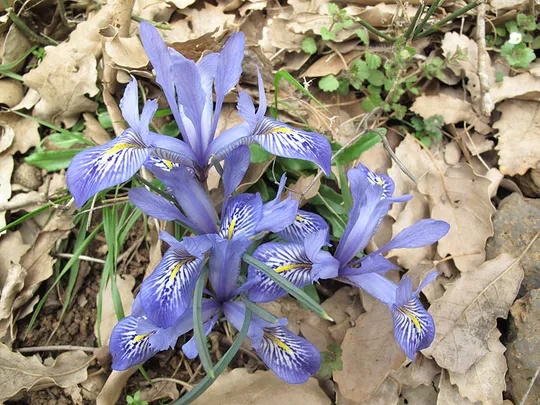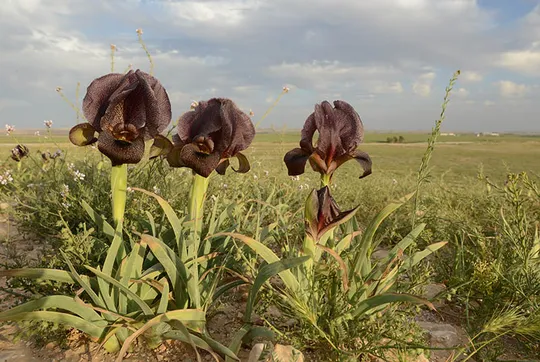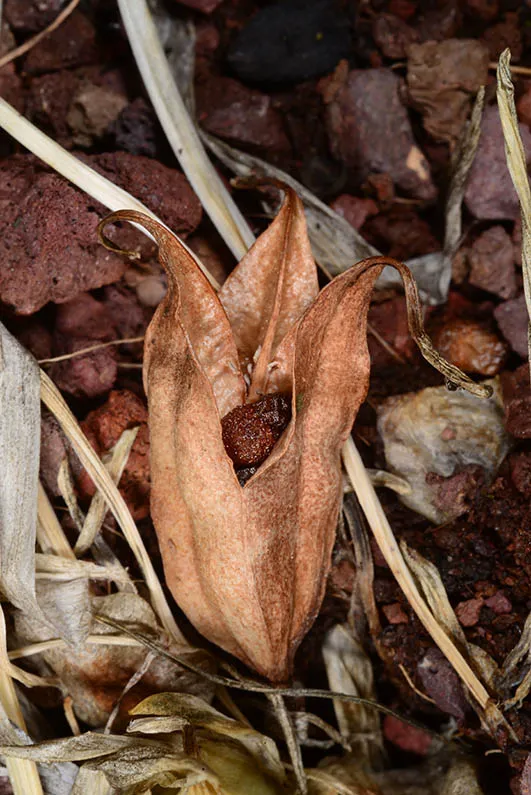Hayne's Iris, Gilboa Iris
Iris haynei
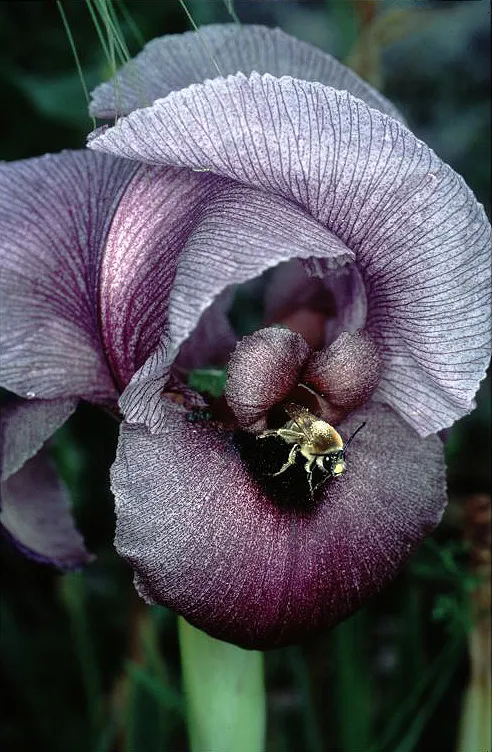
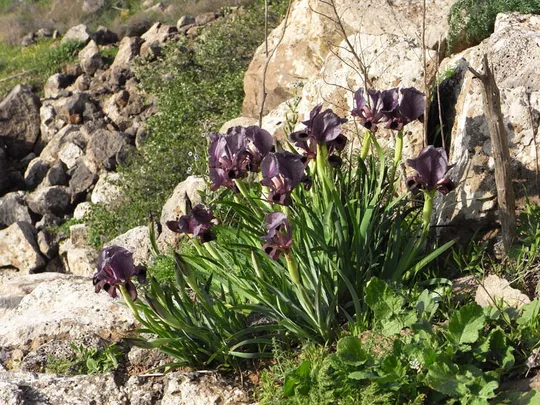
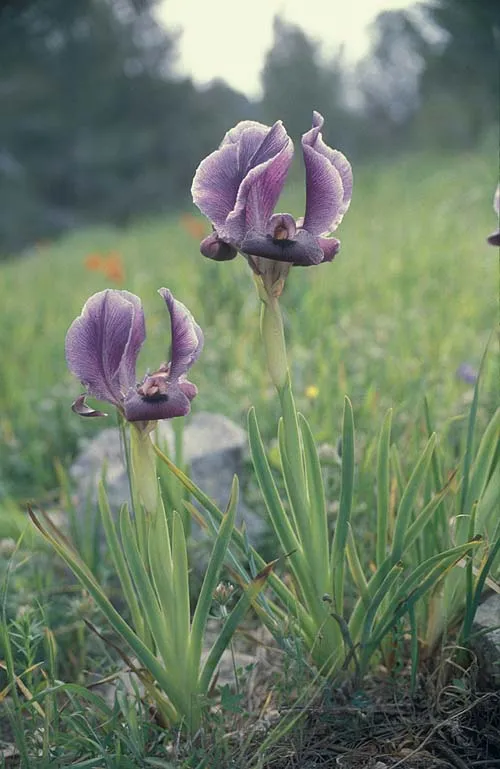
Iris haynei is a geophyte in the Iris section Oncocyclus. It is 35-50 cm tall and grows in clumps created by vegetative reproduction, in each of which, there are several shoots with several sword-like leaves. A single large fragrant flower emerges from each shoot. It is about 10 cm across, and higher than it is wider. The veined perianth is violet to purple. There is a black patch on the lip of the flower, near the opening of the pollination tunnel, whose base is adorned with black hairs. I. haynei is pollinated by large male bees from the Eucirinii group, which shelter in the flowers at night and during rainy, stormy periods. I. haynei blooms in mid-March; it appears a week earlier in low areas and a week to ten days later in high areas. The seeds have elaiosomes (a fatty structure that attracts insects) which is collected by harvester ants that disperse the seeds.
Endemic to the Gilboa and eastern Samaria. Common to the eastern portion of the Gilboa Ridge from Mount Barkan to Mount Malkishua. Outside of the Gilboa, the species is rarer, appearing in a few local patches. Many populations exist in eastern Samaria, in patches from the Wadi Malih region and Um Zuka ridge to Wadi Tirtsa (Wadi Fara). South of Wadi Tirtsa and up to Wadi Makuk, the species gradually changes to I. atrofusca.
The habitats of Iris lortetii and I. haynei do not overlap in Samaria: in the Maǧdal Bani-Fadil (Migdalim Junction) area, I. lortetii grows in the higher, western part, while Iris haynei grows in the lower belt, which is warmer and more arid.
Grows mostly on limestone and dolomite, and not on the chalk rocks of the Sartaba region, perhaps because of the more arid nature of the rock. Altitude range: from -150 to 550+ m. On the Gilboa, it grows in the ecotone shrubland with Ferula communis and Euphorbia hierosolymitana, with some presence of Pistacia lentiscus and Ceratonia siliqua. In addition, it grows on the edges of agricultural fields and in planted Aleppo pine forests.
Belongs to the Iris section Oncocyclus. Very similar to I. atrofusca, to the point that there have been doubts regarding the independent status of Iris haynei. There is a possibility that the populations in the Gilboa and eastern Samaria are a subspecies of I. atrofusca. The identity of the dark iris populations in the southern Golan is also uncertain. These were formerly identified as Iris haynei, the “Jordan” iris or I. atropurpurea, but the results of research over the past years have shown that they are closer to Iris atrofusca of the Judean Desert and the Gil’ad Mountains. Until its taxonomic status is resolved, we consider Iris haynei as an independent endemic species whose preservation is important.
• Plans for the establishment of a settlement in the Gilboa threaten large populations of the species. The security wall built on the Gilboa Ridge has destroyed habitats, and as a result, several hundred of flower groups were transferred to the Mount Barkan area. It is very attractive to flower pickers. Dense pine tree plantations in the Gilboa cast shade on iris patches causing them to deteriorate, while controlled cattle grazing actually encourages its spread, leading to the conclusion that total protection from grazing could in fact reduce its growth.
• The populations are very patchy and fragmented, with the exclusion of a large area at the top of the Gilboa where a huge population grows.
• On the Gilboa, the species is found over a non-continuous area of approximately 10 sq. km. The populations are divided between two primary patches: 1) Mount Barkan-Ma’ale Gilboa (large, dense populations). 2) Mount Malkishua (small, sparse populations). Many small populations exist on the Um-Zuka ridge in eastern Samaria up to Argeman, in an area closed off for IDF training purposes, and population sizes in the area remain stable. The population at Wadi Piran-Talkid suffers greatly and its density has dropped drastically.
• If Iris haynei is considered an independent species, its endangered status in Israel is global, because the species is endemic to Israel.
• Iris haynei populations are protected within the boundaries of the Gilboa and Um Zuka Nature Reserves.
Prevention of development in areas where the species grows, particularly on the Gilboa. The land should be left as an open ecotone steppe, using controlled grazing as a management tool and preventing additional afforestation.
Endemic to Israel.
A geophyte with an eye-catching purple flower, the best known in the iris section Oncocyclus. It has been classified as a red species because it is endemic to the Gilboa and eastern Samaria, and threatened by development, picking, afforestation and over-grazing. The Gilboa populations are rich and large, some located within the nature reserve and most of them outside its boundaries.
פז, ע. 1988. בארץ אהבתי. הוצאת מסדה.
Kintisch, E. 2005. Israeli Controversy Blossoms over Protecting Gilboa Iris. Science 308:1251
Current Occupancy Map
| 1000 squre meter pixel | 5000 squre meter pixel | 10000 squre meter pixel | |
|---|---|---|---|
| number of observations | 0 | 0 | 0 |
| in total pixels | 0 | 0 | 0 |
| Family | Iridaceae |
| Classification | On the endangered species list |
| Ecosystem | Semi-Steppe Belt |
| Chorotype | Eastern Mediterranean |
| Conservation Site | Gilboa |
| Rarity |
1
1
6
|
|---|---|
| Vulnerability |
0
0
4
|
| Attractiveness |
0
3
4
|
| Endemism |
0
3
4
|
| Red number |
1
3.7
10
|
| Peripherality | 0 |
| IUCN category | DD EW EX LC CR EN VU NT |
| Threat Definition according to the red book | Vulnerable |
 Participated:
Participated:

